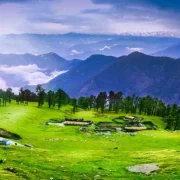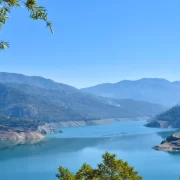
Yamunotri: A Sacred Himalayan Gem
Yamunotri, nestled in the majestic Garhwal Himalayas of Uttarakhand, India, is one of the four sacred sites of the Char Dham Yatra, a pilgrimage that also includes Gangotri, Kedarnath, and Badrinath. Revered as the source of the Yamuna River, the second holiest river in India after the Ganges, Yamunotri holds immense spiritual significance. The journey to this serene destination is not just a pilgrimage but a trek through nature’s pristine beauty, offering pilgrims and travelers a chance to reconnect with spirituality and the natural world.
Historical and Spiritual Importance
Yamunotri is dedicated to Goddess Yamuna, the daughter of Surya (the Sun God) and sister of Yama (the God of Death). According to Hindu mythology, a bath in the holy waters of the Yamuna River is believed to absolve a person of their sins, offering them protection from a painful death. This belief has made Yamunotri a significant pilgrimage site for Hindus seeking salvation and purification.
The temple at Yamunotri, perched at an elevation of about 3,293 meters (10,804 feet), was constructed in the 19th century by Maharani Guleria of Jaipur. Though the temple has been renovated multiple times due to damage from natural calamities, its spiritual essence remains unchanged. The idol of Goddess Yamuna, made of black marble, resides in the temple, with pilgrims coming from across India to pay their respects.
The Yamuna River and Surya Kund
Yamunotri is most famous for being the source of the Yamuna River, originating from the Yamunotri Glacier, located at an altitude of about 4,421 meters (14,505 feet) near the Bandarpunch Peak. Though the actual source is a frozen lake and glacier that is difficult to access, the pilgrims symbolically worship the river at the temple in Yamunotri.
Adjacent to the Yamunotri Temple is Surya Kund, a natural hot spring that is believed to be a manifestation of the Sun God, Surya, the father of Goddess Yamuna. The water in Surya Kund is extremely hot, reaching boiling temperatures. Pilgrims often cook rice and potatoes in the spring’s waters, which are later offered as prasad (a religious offering) to the Goddess. The geothermal activity of this kund adds a fascinating layer to the sacredness of the site, and its miraculous existence in such cold temperatures amazes visitors.
Trekking to Yamunotri
Reaching Yamunotri is a significant part of the pilgrimage. The trek begins at Janki Chatti, a small hamlet located about 6 kilometers from Yamunotri. Janki Chatti serves as the base camp for pilgrims, providing basic lodging and amenities. The path to Yamunotri is an uphill climb through dense forests, gushing waterfalls, and panoramic views of snow-clad peaks. It is a journey that tests one’s endurance but rewards with immense natural beauty and a sense of spiritual fulfillment.
For those unable to trek, options like palanquins, ponies, and even helicopters are available, ensuring that people of all ages and physical capabilities can visit the holy site.
Best Time to Visit
Yamunotri Temple remains open to the public from May to November, as the region is prone to heavy snowfall during winter, making the area inaccessible. The ideal time to visit is during the summer months of May and June, and then again in September and October, when the weather is pleasant and the trekking conditions are favorable. The temple opens on the auspicious day of Akshaya Tritiya in May and closes after Diwali in November, with a special prayer marking the end of the pilgrimage season.
Nearby Attractions
Beyond the temple, Yamunotri is surrounded by several natural attractions that draw trekkers and nature enthusiasts. The Bandarpunch Peak, which is visible from Yamunotri, is a popular trekking destination. The dense forests, alpine meadows, and crystal-clear streams along the trek create an unparalleled experience for visitors.
Janki Chatti itself is known for its thermal springs, providing weary pilgrims a chance to relax and rejuvenate in the warm, mineral-rich waters after their journey. The nearby village of Hanuman Chatti, located about 13 kilometers from Yamunotri, is another scenic spot, where the Yamuna and Hanuman Ganga rivers converge.
Conclusion
Yamunotri is not just a pilgrimage; it is a spiritual retreat into the Himalayas, where divinity meets nature. The journey to this sacred site offers a chance for self-reflection, physical endurance, and spiritual awakening. Whether it’s the allure of the mighty Yamuna River, the natural beauty of the Garhwal Himalayas, or the religious significance of the temple, Yamunotri continues to captivate the hearts of pilgrims and travelers alike.
Recent Posts
Abbott Mount: A Hidden Gem in the Hills of Uttarakhand
Champawat: A Gateway to the Scenic Beauty and Heritage of Uttarakhand
New Tehri: A Modern Town with a Blend of Nature and Culture
All Categories

Thailand




